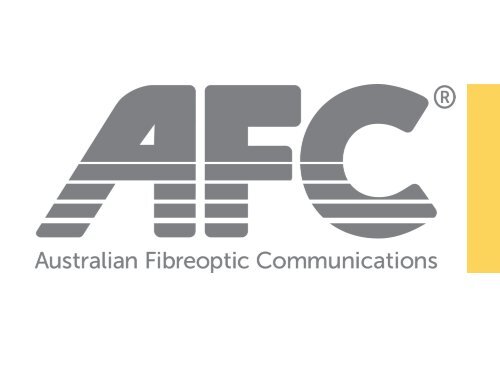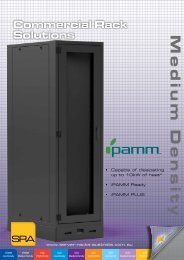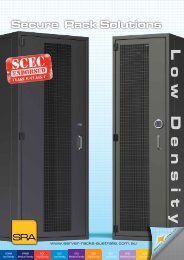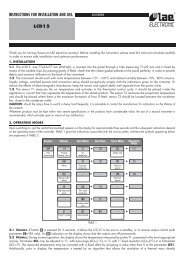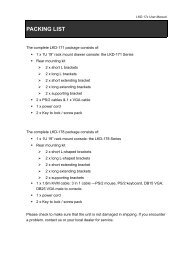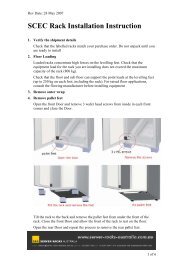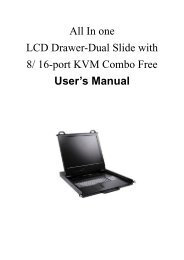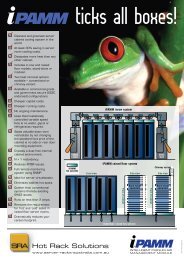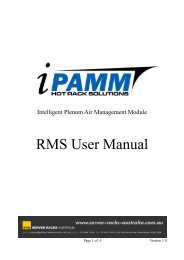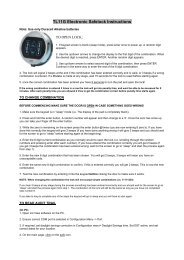AFC - Server Racks Australia
AFC - Server Racks Australia
AFC - Server Racks Australia
You also want an ePaper? Increase the reach of your titles
YUMPU automatically turns print PDFs into web optimized ePapers that Google loves.
Let the Physical Layer<br />
Be the Silver Lining in your Cloud<br />
Presented by Michele Hart
Cloud Computing<br />
Converged Infrastructure + Shared Services = Increased Bandwidth<br />
• Shared Services<br />
• Shared Resources<br />
• Shared Software<br />
• Shared Infrastructure
Cloud Computing<br />
Converged Infrastructure + Shared Services = Bandwidth Need
Cloud Computing<br />
Converged Infrastructure + Shared Services = Bandwidth Need<br />
• Cost<br />
• Virtualisation<br />
• Multi-tenancy<br />
• Reliability<br />
• Scalability<br />
• Security<br />
• Maintenance
Cloud Computing<br />
Challenges<br />
• Bandwidth Bottlenecks
The Physical Layer<br />
• The fundamental building block<br />
• Cables, cards, designs<br />
• Topologies<br />
• Healthy and Strong<br />
• Flexibility
Fibre Hygiene<br />
• How Healthy is your connectivity?<br />
• Do you know what to look for?<br />
• What are the consequences?
Fibre Hygiene<br />
Connector End Faces<br />
SIMPLEX CONNECTOR<br />
MULTI-FIBRE CONNECTOR
Fibre Hygiene<br />
Focus on the Connection<br />
Bulkhead Adapter<br />
fibre Connector<br />
Ferrule<br />
Fibre<br />
Alignment<br />
Sleeve<br />
Physical<br />
Contact<br />
Alignment<br />
Sleeve
Fibre Hygiene<br />
What makes a good fibre connection?<br />
The 3 basic principles that are critical to achieving an<br />
efficient fibre optic connection are “The 3 P’s”:<br />
• Perfect Core<br />
Alignment<br />
Light Transmitted<br />
• Physical Contact<br />
• Pristine<br />
Connector<br />
Interface<br />
Core<br />
Cladding<br />
CLEAN
Fibre Hygiene<br />
What makes a bad fibre connection?<br />
• A single particle<br />
mated into the<br />
core of a fibre can<br />
cause significant<br />
back reflection,<br />
insertion loss<br />
and even<br />
equipment<br />
damage.<br />
Light<br />
Core<br />
Cladding<br />
Back Reflection<br />
DIRT<br />
Insertion Loss
Fibre Hygiene<br />
Particle Migration<br />
15.1µ<br />
10.3µ<br />
11.8µ<br />
Core<br />
Cladding<br />
Actual fibre end face images of particle migration
1<br />
Fibre Hygiene<br />
Contamination and Signal Performance<br />
CLEAN CONNECTION<br />
Fibre Contamination and Its Effect on Signal Performance<br />
Back Reflection = -67.5 dB<br />
Total Loss = 0.250 dB<br />
3<br />
DIRTY CONNECTION<br />
1. Clean Connection vs. 3. Dirty Connection
Fibre Hygiene<br />
Contamination<br />
SINGLEMODE<br />
FIBRE<br />
Common types of contamination and defects include the following:<br />
Dirt Oil Pits & Chips Scratches
Fibre Hygiene<br />
Consequences<br />
• Failed ORL and connector reflectance/loss<br />
• Laser ‘chirping’ & high RIN caused by reflections<br />
• High link loss and connector loss<br />
• ISI and other undesired defects in the WDM system<br />
• Intermittent bit/block/FEC errors and protection switches<br />
• Error packets or cells at layer 2/3<br />
• Data re-transmission requests at higher layers<br />
• LOSS OF TIME, NETWORK OUTAGES, INCREASED FAILURE RATE
Fibre Hygiene<br />
ISO/IEC 61300-3-35<br />
• A set of requirements for Fibre<br />
Optic connector quality<br />
• Designed to guarantee insertion<br />
loss and return loss performance<br />
• Used as a common reference<br />
between supplier & customer or<br />
between work groups<br />
• Used as a condition for accurate<br />
testing of components or links
Example of Pass/Fail Criteria (SM-UPC)<br />
Fibre Hygiene<br />
ISO/IEC 61300-3-35<br />
• These criteria are designed to<br />
guarantee a common level of<br />
performance<br />
• Separate criteria for different<br />
connector types<br />
• SM-UPC (RL>45db)<br />
• SM-APC<br />
• SM-PC (RL>26dB)<br />
• MM<br />
Core Zone<br />
Cladding Zone<br />
Contact Zone<br />
ZONE NAME SCRATCHES DEFECTS<br />
A. CORE (0–25μm) None None<br />
B. CLADDING<br />
(25–120μm)<br />
C. ADHESIVE<br />
(120–130μm)<br />
No limit 3μm<br />
No limit<br />
No limit < 2μm<br />
5 from 2–5 μm<br />
None > 5μm<br />
No limit<br />
• Multi-fibre<br />
D. CONTACT<br />
(130–250μm)<br />
No limit<br />
None => 10μm
Fibre Hygiene<br />
ISO/IEC 61300-3-35<br />
SUBJECTIVE INSPECTION:<br />
???<br />
OBJECTIVE INSPECTION:<br />
FAIL<br />
3.0μm<br />
2.4μm<br />
8.6μm<br />
• Many Factors impact results:<br />
• Display settings<br />
• Ambient lighting<br />
• Operator eyesight<br />
• Operator judgment<br />
• Actually testing is very difficult<br />
• Certification is not practical<br />
• Eliminate variation in results<br />
• Certify and record product quality<br />
• All skill levels can certify quality<br />
• Make advanced criteria simple<br />
• Improve performance & yields
Fibre Hygiene<br />
ISO/IEC 61300-3-35<br />
ISO/IEC 11801<br />
References ISO/IEC 14763-3 for all fibre testing<br />
ISO/IEC 14763-3<br />
Testing fibre optic cabling in premises networks<br />
IEC 61280-4-1<br />
Insertion loss testing of multimode fibre optic cabling<br />
IEC 61280-4-2<br />
Insertion and return loss testing of singlemode fibre optic cabling<br />
IEC 61280-4-4 Ed.2<br />
PMD testing of installed fibre optic cabling<br />
IEC 61757-1<br />
International Standard for fibre optic sensors<br />
ITU-T G.650.3<br />
ITU Recommendation for fibre characterization<br />
TIA-568-C.0<br />
Pending addendum<br />
Purchasing specifications & work instructions<br />
TIA-942<br />
Data Centre Design
Fibre Hygiene<br />
Inspect & Clean<br />
© <strong>AFC</strong> Group Pty Ltd 2012 21
Fibre Hygiene<br />
Summary<br />
• Connectors are valuable and essential, but they must be handled properly<br />
• CONTAMINATION is the #1 source of troubleshooting in optical networks<br />
• This challenge is easily overcome with proactive inspection and cleaning<br />
• Visual inspection of fibre optic connectors with a microscope is the only way<br />
to determine if connectors are clean before they are mated<br />
• Proactive inspection is easy, and the benefits are:<br />
• Reduced Network Downtime<br />
• Reduced Troubleshooting<br />
• Optimized Signal Performance<br />
• Prevention of Network Damage<br />
• Always “INSPECT BEFORE YOU CONNECT”
The Physical Layer<br />
• The fundamental building block<br />
• Cables, cards, designs<br />
• Topologies<br />
• Healthy and Strong<br />
• Flexibility
Dynamic Cabling Solution<br />
• Smarter cabling options<br />
• Easy Patching<br />
• Flexibility<br />
• Smart Management<br />
• Density<br />
• Migration options 10/40/100GigE<br />
© <strong>AFC</strong> Group Pty Ltd 2012 24
Easy Patching<br />
MT - MPO - MTP - MTP Elite<br />
© <strong>AFC</strong> Group Pty Ltd 2012 25
Flexibility<br />
Modular Product Solution<br />
© <strong>AFC</strong> Group Pty Ltd 2012 26
Flexibility<br />
No RU Space? No Problem!<br />
© <strong>AFC</strong> Group Pty Ltd 2012 27
Flexibility<br />
X-Connects<br />
© <strong>AFC</strong> Group Pty Ltd 2012 28
Smart Management<br />
SAN Director Spaghetti!<br />
© <strong>AFC</strong> Group Pty Ltd 2012 29
Smart Management<br />
Hardwired SAN Director to X-connect<br />
© <strong>AFC</strong> Group Pty Ltd 2012 30
Density<br />
12 Fibres, One Patch<br />
© <strong>AFC</strong> Group Pty Ltd 2012 31
Density +<br />
© <strong>AFC</strong> Group Pty Ltd 2012 32
Density ++ 2688F in 42RU<br />
© <strong>AFC</strong> Group Pty Ltd 2012 33
Migration Options<br />
OM4 MM & OS2 SM Bend Tolerant Fibre<br />
OM4 BT
Migration Options<br />
TIA-568-C.0-2 upgrade to 40 and 100G parallel optics<br />
© <strong>AFC</strong> Group Pty Ltd 2012 35
ANSI/TIA-568-C.0<br />
Generic Telecommunications Cabling for Customer Premises<br />
• MTP/MPO links offer standards based DX polarity management<br />
specified via connectivity methods A, B and C<br />
• 568-C.0-2 (yet to be released) will define upgrade path<br />
configurations from existing A, B or C type DX circuits for 40 and<br />
100G parallel signals<br />
• TIA-568-C.0-2 committee voting shortly in this regard<br />
• And most importantly - only MTP/MPO connectivity is<br />
recognised in 568-C.0-2 to support 40 & 100G channels<br />
© <strong>AFC</strong> Group Pty Ltd 2012 36
Channel Losses ISO/IEC<br />
11801 & TIA-568-C.0-2<br />
Application 50/125µm LOMMF OM3 50/125µm LOMMF<br />
OM4<br />
10GBASESR/SW<br />
40GBASE-SR4<br />
100GBASE-SR10<br />
2.55dB @ 850nm<br />
300m channel<br />
1.9dB @ 850nm<br />
100m channel<br />
1.9dB @ 850nm<br />
100m channel<br />
3.1dB @ 850nm<br />
550m channel<br />
1.5dB @ 850nm<br />
150m channel<br />
1.5dB @ 850nm<br />
150m channel<br />
© <strong>AFC</strong> Group Pty Ltd 2012 37
Summary<br />
• Polarity?<br />
• Patching and configuration implications?<br />
• Ease of management?<br />
• System losses meet TIA-568 & IEC-11801?<br />
• Upgrade to 40/100GigE?<br />
© <strong>AFC</strong> Group Pty Ltd 2012 38
Thank You<br />
© <strong>AFC</strong> Group Pty Ltd 2012


